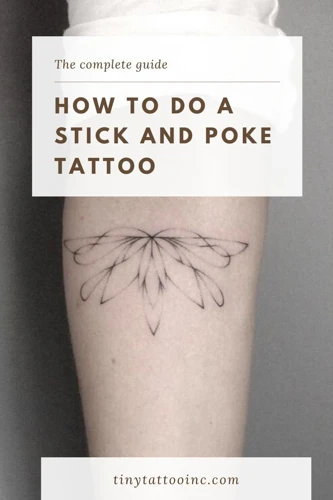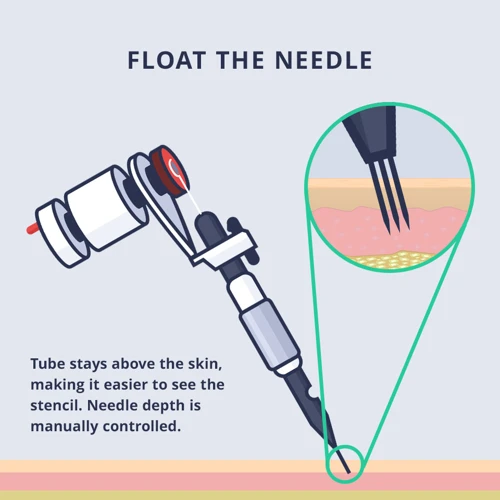Are you considering learning how to tattoo from home? With the right materials and some practice, you can become a professional tattoo artist without leaving your house. This guide will walk you through the basics of home tattooing, from setting up your workspace to tips for creating stunning works of art. We’ll cover the equipment you’ll need, the best practices for safety and hygiene, and step-by-step instructions for creating a beautiful tattoo. With this guide, you’ll be well on your way to becoming a professional tattoo artist in no time!
Contents
Safety and Preparation

Tattoo Supplies
Before you start learning how to tattoo from home, you need to make sure you have all the necessary supplies and equipment. This includes a tattoo machine, needles, ink, and a variety of other tools. Professional quality tattoo supplies are essential for ensuring safety and achieving the best possible results. You should also make sure to purchase any additional supplies such as cleaning solution, bandages, and aftercare products.
Setting Up Your Home Tattoo Studio
Once you have your supplies, you need to set up a space where you can comfortably work. This should be a clean, well-lit area with plenty of room to work. You should also make sure the area is free from distractions and that your workspace is well-organized. Additionally, it is important to have good ventilation in the area to reduce the risk of infection.
Safety Rules
When learning how to tattoo from home, safety is of the utmost importance. You should make sure to follow all safety protocols, such as wearing gloves and thoroughly sterilizing all tools and supplies. Additionally, it is important to stay up-to-date on local health laws and regulations regarding tattooing. By following these safety rules, you can ensure that your home tattooing experience is as safe and successful as possible.
Tattooing Basics

Tattoo Design
Creating a unique tattoo design is the first step in learning how to teach yourself to tattoo. Drawing out a design is the best way to make sure you are happy with the end result. Try drawing with a pencil and paper, or use digital tools to create a design. Make sure to plan out the size, shape, and color of the tattoo before moving forward.
Skin Preparation
Before starting the tattoo, the area of skin must be cleaned and prepped. Use a clean cloth and some rubbing alcohol to clean the skin. Make sure to sterilize any tools or machines you will be using as well. Once the area is prepped, you can begin the tattooing process.
Tattoo Machine
To begin learning how to teach yourself to tattoo, you must first understand the basics of a tattoo machine. A tattoo machine is used to make the ink penetrate into the skin. It can be used to create a variety of lines, shades, and depths. Make sure to understand how to use the machine before attempting a tattoo.
Ink Application
Once the design is complete and the skin is prepped, it is time to apply the ink. Make sure the ink is not too watery, as this can lead to a poor-quality tattoo. Begin by filling in the outline of the design and then adding the shading. Use strong pressure when applying the ink to ensure it penetrates the skin. Work slowly and ensure the lines are even. Once the tattoo is complete, it is important to clean and wrap the area to prevent infection.
Practice Tattooing

Practice Tattooing on Fruit and Vegetables
Practicing tattooing on fruit and vegetables is a great way to start developing your skills. The softness of the surface allows for easy tracing of your designs. It is also an inexpensive way to practice. Make sure you do not use the same fruit or vegetable for more than one practice tattoo.
Practice Tattooing on Pig Skin
Practicing tattooing on pig skin is a great way to get a feel for how the skin will react to the needle. You can purchase pig skin from most tattoo supply stores. Make sure you use a new piece of pig skin for each practice tattoo.
Practice Tattooing on Artificial Skin
Practicing tattooing on artificial skin gives you the closest feel to tattooing on real skin. You can purchase artificial skin from most tattoo supply stores. Make sure you use a new piece of artificial skin for each practice tattoo.
Final Steps
Aftercare
It is essential to properly care for a new tattoo. This is done by keeping the area properly moisturized, avoiding the sun, and avoiding any activities that may damage the tattoo. Moisturizing the area two to three times a day is recommended. Additionally, it is important to avoid direct sunlight and any activities that involve sweating, such as swimming and exercise, for at least two weeks.
Sterilization
It is also important to ensure that all of the equipment used is properly sterilized. Using only new, sterile needles is essential for preventing infection. Additionally, any other equipment that comes in contact with the skin should be cleaned and sanitized before use. This will help to ensure a safe and successful tattooing experience.
Frequently Asked Questions
What type of equipment do I need to start tattooing at home?
Tattoo Machine: A tattoo machine is essential for any home-based tattoo artist. It is a motorised device that drives a needle up and down to create a tattoo. When choosing a tattoo machine, consider the size and weight of the machine. You should also look at the type of needles used, including the size, shape and type.
Tattoo Ink: You will need to purchase high-quality tattoo ink to produce a professional-looking tattoo. Make sure to purchase a variety of colours to create your desired design.
Tattoo Needles: Tattoo needles are used to inscribe the ink into the skin. There are different types of needles available, including round, flat and magnum needles. Choose the needles that best suits your style and design.
Tattoo Gloves: Tattoo gloves protect you from any possible contamination. Non-sterile gloves should be used when handling the equipment or when preparing the skin.
Tattoo Stencil: Stencils are used to create a template before the actual tattooing begins. This ensures that the design is correctly placed and positioned before the tattoo is applied.
Tattoo Transfer Paper: Transfer paper is used to transfer the design onto the skin before tattooing. It ensures that the design is clear and accurate before the tattooing begins.
Tattoo Aftercare Products: Aftercare products are essential for healing and maintaining the tattoo. These include antibacterial ointments, soaps and lotions.
Is it Legal to Tattoo at Home?
In most cases, the answer is no. Generally, it is illegal to do tattoos in a home-based setting. It is important that you check with your local health department to determine what is legal in your area.
- In some states, it is illegal to tattoo anywhere other than a regulated, professional tattoo studio.
- In some areas, you may need a special permit to tattoo in a home-based setting.
- In some states, you may need to be certified by the Department of Health before tattooing in a home-based setting.
- Some states require that the person receiving the tattoo is 18 years or older.
- In some areas, you may need to register your business with the local health department.
It is important to note that even if it is legal in your area, you should not tattoo anyone without proper training and safety protocols. Home tattooing is not recommended and can be dangerous if not done properly. The risks of infection and other complications are much higher when done in a home-based setting. Professional tattoo artists have access to the proper equipment, materials and supplies, and they understand the necessary safety protocols. They also have experience in using the equipment and supplies and have the necessary knowledge to ensure the safety of their clients.
How do I find a safe and reliable source for tattoo supplies?
- Check Reviews: Before buying supplies, read reviews from trusted sources, such as tattoo forums and review websites.
- Look for Reputable Brands: Get tattoo supplies from known brands that have a good reputation in the industry.
- Check for Hygiene: Make sure that the supplies are safe for use and are sterilized properly.
- Check for Quality: Use supplies made of high-quality material that is not prone to breakage.
- Check for Compatibility: Ensure the supplies are compatible with your system and machine.
- Look for Guarantees: Purchase products with a warranty or guarantee of satisfaction.
What Safety Precautions Should I Take When Tattooing at Home?
Wear protective gear: Wear a mask, gloves, and safety glasses to protect yourself from splashes of bodily fluids and potentially infectious materials.
Disinfect equipment: Sterilize any needles, ink, and other equipment before each use and clean the area where you’ll be tattooing.
Use sterile disposable needles: Make sure the needles you use are new, sterile, and disposable to help prevent infection.
Use a single-use ink cup: Avoid reusing ink as it can spread disease. Use a single-use ink cup for each client.
Wash your hands: Wash your hands thoroughly before and after tattooing to avoid spreading germs.
Dispose of waste properly: Place any used needles, ink, and other disposable materials in a sealed container and dispose of it according to local regulations.
How do I avoid infection and cross-contamination when tattooing at home?
Sanitize your workspace: It is important to keep your workspace clean and sanitized when tattooing at home. Make sure the surface is clean and clear of any dirt or debris. Disinfect the surface with a hospital-grade disinfectant, and all tools and equipment you are using.
Wear protective clothing: Always wear protective clothing when tattooing. This includes gloves, a face mask, and protective eyewear. Be sure to change gloves between every client and in between tattooing different parts of the same client.
Use disposable needles: Disposable needles should be used for every client and disposed of immediately after use. All other tools, such as razors, should also be disposed of after each use.
Clean and disinfect your hands: Always make sure to clean and disinfect your hands before and after tattooing. Use a hospital-grade disinfectant and wash your hands with soap and water.
Dispose of all waste: All waste from the tattooing process, such as needles, razors, and ink, should be disposed of properly. This should be done in a sealed container and disposed of according to local regulations.
Maintain good hygiene: Self-care is important for preventing infections and cross-contamination. Make sure to follow good hygiene practices, including washing your hands with soap and water before and after every procedure.
Conclusion
Tattooing at home can be a great way to express yourself and create unique art. With the right knowledge, supplies, and practice, you too can learn how to tattoo from home and create beautiful works of art. With a bit of patience, dedication, and creativity, you can become a great home tattoo artist.
References
- How to Tattoo: Everything You Need to Know About Tattooing – tattoomenow.com
- Everything You Need to Know to Become a Tattoo Artist – tattoo.com